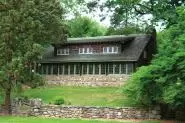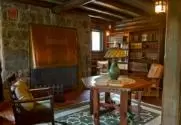One Worth Repeating

I wrote this column last year, but with the annual Craftsman Farms Gala and symposium coming up this weekend, I thought it would bear repeating:
The sun was just beginning to set when I arrived, but I could see the first hint of the moon rising over New York City in the distance. At the edge of the yard, walking along the safety of the tree line, a sleek doe grazed with twin fawns, eyeing me cautiously, wary but certainly not afraid, accustomed to sharing her territory with those of us who come to pay homage to Gustav Stickley and his dream.
I had been to Craftsman Farms countless times in the daylight, but never at night, never completely alone, standing in his yard, walking around what had been his home, his farm, thinking about my own farm, sharing for a fleeting moment our mutual concerns about the weather, the hay crop, the livestock, the broken gate, the plans for an addition to the horse barn.
I was drawn that evening to a stone bench he had built directly in front of the house, a bench that gave each visitor a sweeping view down over the lush front meadow, between the stone pillars marking the main entrance, a place where one could sit and appreciate all that Gustav Stickley had accomplished. But as soon as I sat down, I was overwhelmed by thoughts of his last night at Craftsman Farms.
It would have been a warm evening in August of 1917 when Gustav Stickley took his final walk around Craftsman Farms. His empire had crumbled. Somehow he had lost it all, entirely: his Syracuse furniture factory, his Manhattan restaurant, his Craftsman stores, his publishing company, his Craftsman magazine and, worst of all, his beloved home and farm.
He was 59 years old.
He was bankrupt.
Both of his daughters had been married here in the flower garden, and, as more than one hundred guests looked on, he had danced with each beneath a Gatsby-like glow of Japanese lanterns. He had built homes, quaint cottages for each of them and his new sons-in-law on the property, just yards away from the home where he and Eda, after years of separation, had reunited to raise their children. But this was not just a home for his family, it was the epitome of his dream; it was the culmination of a lifetime of work.
And that warm August night, standing alone, he must have taken his final walk around the stone walls he had built, the trees and gardens he had planted, the fields he had cleared, the cottages and barns he had built, and, of course, his home, brimming with his beloved furniture, each piece hand-picked or custom-made. He was leaving it all behind, even his treasured books, each one left where he had placed it on the chestnut bookcases near the fireplace, returning in total defeat back to Syracuse, empty handed, to live the rest of his life in his daughter’s third floor attic.
He may well have ended his walk that evening here on this same stone bench, with his back to the log home he had designed and built, sitting in silence by himself, completely alone, knowing he would never return in triumph, knowing he had lost it forever, knowing that his career was over, that his spirit was broken.
Not once during that final night could he have imagined that a hundred years later his farm would have become a national historic landmark, that his home would now be a museum, and that a board of directors would be meeting there, discussing plans to further preserve and restore his home, to expand on his dream, to make it more accessible to more people, from local school children to area residents to distant travelers like myself, making plans for future improvements, plans to share a deeper appreciation for who Gustav Stickley was and the manifestation of his dream.

As I sat there, I expected that once the sun had set the farm would be cloaked in darkness, and I would be stumbling around, feeling my way back to my car. But, instead, just as the sun disappeared in the west, a full moon arose in the east, a brilliant full moon, so bright it washed out the surrounding stars, so bright it seemed that that the sun was already rising, shining a light back down upon this home, symbolic of the new life that has begun at Craftsman Farms.
This new life, this new light that has been cast upon Craftsman Farms cannot not be credited to any one individual, but to an ever-changing group of individuals working together, people who come, leave their mark, make their contribution, then sometimes move on, replaced by others caught up not by the mystique of Gustav Stickley, but by the philosophy he espoused: that the quest for a simple life — a life centered in the home, where a family could gather, could take strength from one another, could make plans for their future, could lead lives that mattered, that made a difference — that this quest was worth the effort it required.
I imagine that in 1913 Craftsman Farms was a magical place just as it is today, a virtual thirty-acre oasis, nestled in the New Jersey woods that still protect it from the noise of the surrounding highways. It is a place I feel blessed to have come to know, and I hope you will someday have the opportunity — that you will make the opportunity — to come here, and take a walk with Gustav Stickley.

Until next Monday,
Have a great week!
Bruce
For more information, please go to http://www.StickleyMuseum.org.
And if you have not seen one yet, here is the brochure for the 28th National Arts and Crafts Conference at the Grove Park Inn on February 20-22:
http://www.arts-craftsconference.com/images/Brochure.2015.pdf
